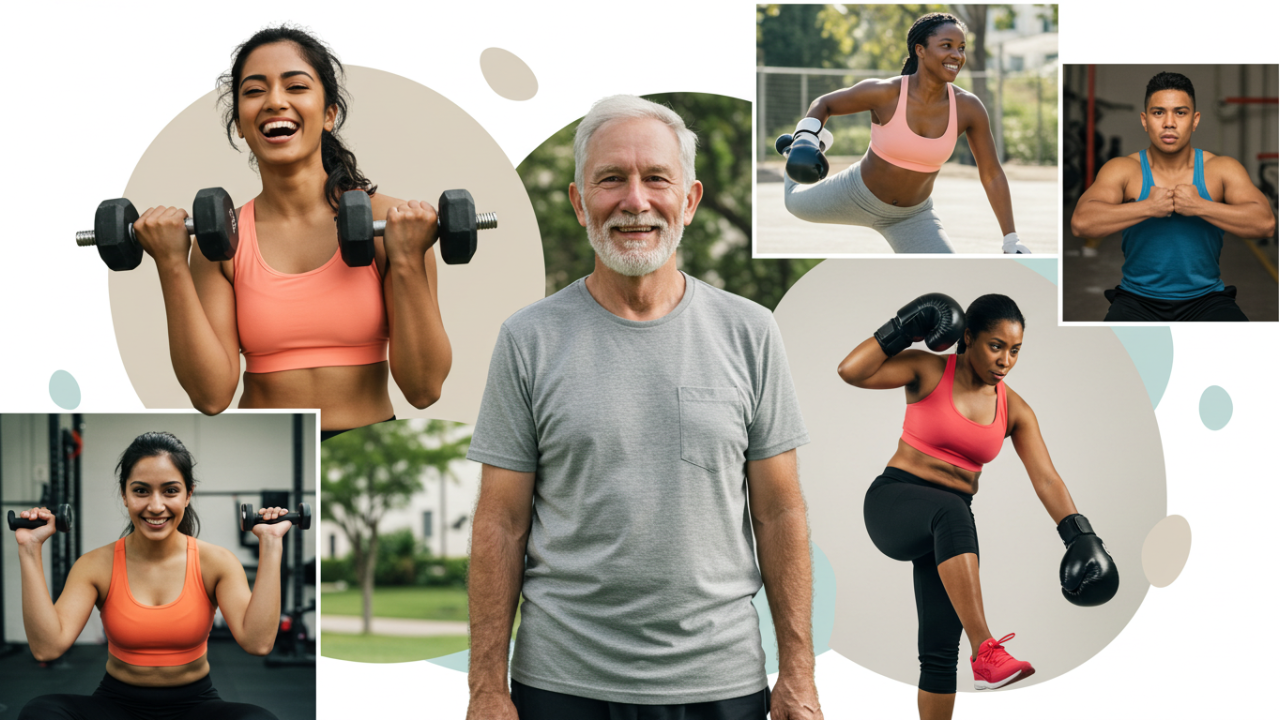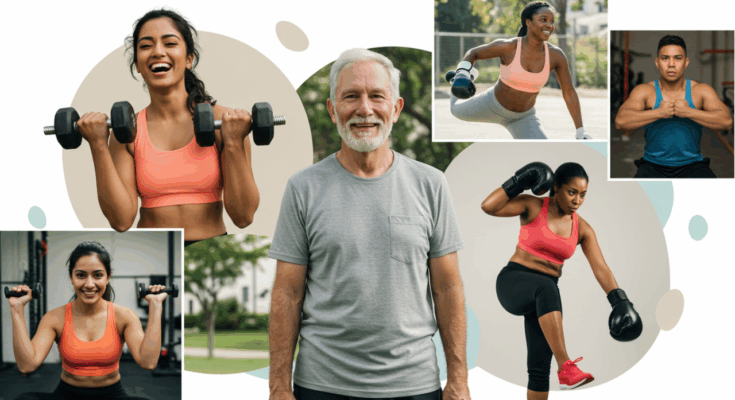In 2025, fitness is no longer a one-size-fits-all pursuit reserved for gym buffs or marathon runners. The modern wellness landscape celebrates inclusivity, recognizing that every body—regardless of age, size, or ability—deserves movement that’s both enjoyable and impactful. With stress levels rising and sedentary habits creeping in, finding fun, effective ways to stay active is key to health and happiness. Recent studies show that enjoyable exercise boosts adherence by up to 40%, making it a game-changer for long-term vitality.
This guide offers practical strategies, creative workouts, and answers to common questions like “How do I stay motivated?” or “What if I hate gyms?” Whether you’re a beginner, a senior, or someone with mobility challenges, you’ll discover actionable ways to make fitness a joyful part of your life.
Why Fun Matters in Fitness
Exercise doesn’t have to feel like punishment. When you enjoy movement, your brain releases endorphins, reducing stress and enhancing mood, which makes you more likely to stick with it.
A 2025 report from the American Heart Association notes that consistent physical activity—any kind—lowers heart disease risk by 20-30% and improves mental health.
The secret? Align workouts with your interests. Love music? Dance workouts are your jam. Prefer nature? Hiking or outdoor yoga beckons. This approach tackles the common barrier: “I get bored.” Fun fuels consistency, and consistency fuels results.

The Science of Effective Fitness
Effective doesn’t mean extreme. The CDC recommends 150 minutes of moderate aerobic activity weekly, plus two days of strength training, for optimal health.
Moderate means you can talk but not sing—think brisk walking. Strength can be bodyweight exercises, no gym required. Even low-impact activities, like swimming, improve joint health and energy levels, especially for diverse bodies.
Track progress with simple metrics: Can you climb stairs without puffing? That’s a win.
Fun Fitness Ideas for Every Body
Here are four engaging, adaptable workouts designed for accessibility, each taking 20-30 minutes and requiring minimal equipment. They address inclusivity for beginners, seniors, or those with physical limitations.
Dance Party Cardio: Move to Your Beat
Who It’s For: Anyone who loves music—beginners, kids, or those with joint concerns.
What You Need: A playlist, space to move, and optional comfy shoes.
How-To:
- Pick 5-6 upbeat songs (20 minutes total).
- Dance freely—sway, twirl, or follow YouTube dance-alongs (Zumba or hip-hop).
- Adapt: Seated chair dancing for mobility issues; keep arms moving.
- Cool down with slow stretches to a calm track.
- Why It Works: Burns 150-300 calories, boosts mood, and improves coordination.
For seniors, it enhances balance.
Tip: Start with 10 minutes if new. Apps like Just Dance offer guided moves.
Nature Walk Circuit: Outdoor Adventure
Who It’s For: Nature lovers, those seeking low-impact options.
What You Need: Park or backyard, comfy clothes.
How-To:
- Walk briskly for 10 minutes, noting surroundings (trees, sounds).
- Pause for 5 minutes of bodyweight exercises: 10 squats, 10 arm circles, 10 toe touches.
- Walk another 10 minutes, faster if able.
- Adapt: Use a cane or wheelchair-friendly paths; focus on upper-body moves.
Why It Works: Combines cardio and strength, reduces stress via nature exposure.<grok:render type=”render_inline_citation”>
7
Studies show outdoor activity cuts anxiety by 20%.<grok:render type=”render_inline_citation”>
8
Tip: Invite a friend for motivation; track steps with a phone.
Chair Yoga Flow: Gentle Strength and Flexibility
Who It’s For: Seniors, office workers, or those with limited mobility.
What You Need: Sturdy chair, optional yoga mat.
How-To:
- Sit tall; inhale, raise arms overhead, exhale, lower (5 reps).
- Twist gently to each side, holding 10 seconds (5 per side).
- Lift one leg at a time, hold 5 seconds (10 reps per leg).
- End with deep breaths, hands on heart, for 1 minute.
Why It Works: Improves flexibility, strengthens core, and reduces joint pain.
Ideal for addressing “I’m too stiff to exercise.”
Tip: Free YouTube videos guide chair yoga; start with 15 minutes.
Playful Strength Games: Family-Friendly Fitness
Who It’s For: Families, beginners, or those craving fun.
What You Need: Open space, optional light weights (water bottles work).
How-To:
- Play “Simon Says” with exercises: 10 jumping jacks, 5 push-ups, 10 lunges (10 minutes).
- Relay race: Walk or jog to a marker, do 5 squats, return (3 rounds).
- Adapt: Seated versions or slower paces for kids or seniors.
- End with a group stretch circle, holding hands.
Why It Works: Builds muscle and community; games increase adherence.
Tip: Rotate games weekly to keep it fresh; involve kids for bonding.
Building a Sustainable Fitness Routine
Consistency is king, but it starts with small, joyful steps. Create a weekly plan: Dance Monday, walk Wednesday, yoga Friday. Aim for 3-4 sessions, 20-30 minutes each. Research shows habit formation takes 21-66 days—start with what feels doable.
Personalizing for Your Needs
- Beginners: Start with 10-minute sessions; focus on enjoyment.
- Seniors: Prioritize balance and flexibility; consult doctors for safety.
- Mobility Challenges: Use seated or supported moves; physical therapy apps guide adaptations.
Motivation Hacks
Pair workouts with music or podcasts. Set mini-goals: “I’ll walk to the park this week.” Track progress in a journal or app—seeing improvements like better stamina fuels drive. Buddy up for accountability; group classes (virtual or local) add social spark.
Overcoming Barriers to Fun Fitness
Common obstacles—time, cost, or intimidation—have solutions:
- Time Crunch: Micro-workouts (5-10 minutes) accumulate benefits. Try desk stretches during breaks.
- Budget Limits: No gym needed—use bodyweight or household items. Free YouTube workouts abound.
- Gym Anxiety: Start at home or in nature. Community centers offer affordable, welcoming classes.
If injuries worry you, begin low-impact and consult professionals. Track energy levels; feeling less tired signals success.
Synergy with Nutrition and Rest
Fitness thrives with support. Eat balanced meals—veggies, lean proteins, whole grains—to fuel workouts.
Sleep 7-9 hours; it repairs muscles and boosts motivation.
Hydrate with 8-10 glasses daily for performance.
FAQ
Can I get fit without a gym?
Absolutely—bodyweight exercises, walking, or home dance workouts are effective and free.<grok:render type=”render_inline_citation”>
4
How do I stay motivated long-term?
Make it fun—choose activities you love. Set small goals and track wins, like better mood or stamina.<grok:render type=”render_inline_citation”>
11
What if I have physical limitations?
Adapt with chair exercises or low-impact moves like swimming. Consult a physical therapist for tailored plans.<grok:render type=”render_inline_citation”>
12
How soon will I see results?
Mood and energy improve in 2-4 weeks; strength and fitness gains take 6-12 weeks with consistency.<grok:render type=”render_inline_citation”>
3
Is fun fitness enough for serious health goals?
Yes—moderate, enjoyable exercise meets health guidelines, reducing disease risk and boosting well-being.<grok:render type=”render_inline_citation”>
2



